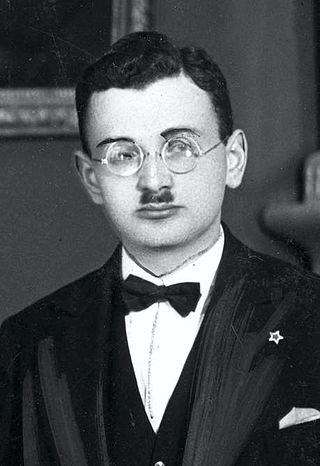
Esperanto is the world's most widely spoken constructed international auxiliary language. Created by the Warsaw-based ophthalmologist L. L. Zamenhof in 1887, it was intended to be a universal second language for international communication, or "the international language". Zamenhof first described the language in Dr. Esperanto's International Language, which he published under the pseudonym Doktoro Esperanto. Early adopters of the language liked the name Esperanto and soon used it to describe his language. The word esperanto translates into English as "one who hopes".

Esperantujo or Esperantio is the Esperanto community; the community of speakers of the Esperanto language and their culture, as well as the places and institutions where the language is used. The term is used "as if it were a country."

L. L. Zamenhof developed Esperanto in the 1870s and '80s. Unua Libro, the first print discussion of the language, appeared in 1887. The number of Esperanto speakers have increased gradually since then, without much support from governments and international organizations. Its use has, in some instances, been outlawed or otherwise suppressed.

Esperanto symbols, primarily the Esperanto flag, have seen much consistency over the time of the language's existence, though a few variations in exact flag patterning and symbology exist.
The Esperanto Association of Britain (EAB) is a registered educational charity whose objective is to advance education in and about the international language Esperanto and to preserve and promote the culture and heritage of Esperanto for the educational benefit of the general public. The organisation was established in 1904.
Norvega Esperantista Ligo was founded in 1911. As the Norwegian arm of the Esperanto movement, its aim is to spread knowledge and use of the international language Esperanto. The league has a modest size of a couple of hundred members, and work done within NEL is mostly voluntary. The youth wing of NEL is Norvega Junularo Esperantista.

Payame Noor University is a large public university in Iran, with its headquarters in Tehran. Established in 1988, is a legal body under the Ministry of Science, Research and Technology. Payame Noor means "the message of light" in Persian.

Esperanto-USA (E-USA) is the largest organization for speakers and supporters of Esperanto in the United States. It was founded in 1952 as the Esperanto League for North America (ELNA) in Sacramento, California. Headquartered in Portland, Maine, Esperanto-USA is a 501(c)3 nonprofit organization and the U.S. affiliate of the Universal Esperanto Association. Phil Dorcas is President of E-USA, and Alexander Vaughn Miller is Vice-President.

Plena Ilustrita Vortaro de Esperanto is a monolingual dictionary of the language Esperanto. It was first compiled in 1970 by a large team of Esperanto linguists and specialists under the guidance of Gaston Waringhien and is published by the Sennacieca Asocio Tutmonda (SAT). It may be consulted online for free.

Vladimir Valentinovich Varankin was a Soviet writer of literature in Esperanto, an instructor of western European history, and director of the Moscow Ped. Instituto for foreign languages. He wrote the novel Metropoliteno.

Hector Hodler was a Swiss Esperantist who had a strong influence on the early Esperanto movement.

The World Esperantist Vegetarian Association is a voluntary association of Esperanto-speaking vegetarians. Founded in 1908, the group's working language is Esperanto, and it is the oldest international organization of vegetarians that is currently active. TEVA published a journal, Vegetarano ("Vegetarian") from 1914 to 1932, revived in 2009 as Esperantista Vegetarano, and has also operated a spirited Internet mailing list through Yahoo! Groups since 2005.

Andreo Cseh was a Hungarian/Dutch Roman Catholic priest and Esperantist known for inventing the Cseh method of Esperanto instruction.

Ahmad Reza Mamduhi is an Iranian translator, author and an iconic figure in the Iranian Esperanto movement. He is best known for his prolific contributions to the Iranian Esperanto Association, as well as publishing two salient books, Aasaan-tarin zabaane donyaa (2005) — a comprehensive step by step Persian textbook concerning with learning/teaching Esperanto — and Padide-ye Esperanto (2007) — originally written in Esperanto by Nobel prize-nominated William Auld, entitled La fenomeno Esperanto. He has also written numerous articles in cultural magazines chiefly in the field of Esperantic Studies.

Usona Esperantisto is the bi-monthly publication of Esperanto-USA, the organization for Esperanto speakers in the United States. Most of the content is in Esperanto, with the remainder in English. Topics include discussions of Esperanto culture, book reviews, short stories, and games.

Isaj Dratwer was a Polish Jewish bacteriologist and esperantist. In the Esperanto movement, Dratwer was a strong advocate, President of the Esperanto Academy, and committee secretary in 1927 and 1931. He often published articles or letters in the Heroldo de Esperanto, Pola Esperantisto and others. He also translated Russian-language novels by Romanov in 1932.

The following outline is provided as an overview of and topical guide to Esperanto:

Zabân-e Pâk is a treatise written in 1944 by Ahmad Kasravi, an Iranian author, contains an edition of the Persian language, which shows some difficulties in refining the language.
The use of Esperanto in the Korean Peninsula can be traced back to the early 20th century.














